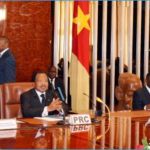Cameroon’s budget for the year 2013 is three thousand, two hundred and thirty six milliard, up from two thousand, eight hundred milliard in 2012.
For the first time in Cameroon, Members of Parliament have been presented a finance bill drafted on the basis of performance based budgeting. The new system is derived from the Growth and Employment Strategy Paper which contains the main projects Cameroon needs to undertake in other to be an emerging country by the year 2035. As such, the one year budget takes into account projects and programmes to be executed in three years. With a 15% increase from the 2012 budget, the 2013 finance bill is aimed at kick starting economic activities in Cameroon after the economic slowdown caused by the global recession of 2008. According to the Minister of Finance, Alamine Ousmane Mey, “the new approach will lay the foundation for our country to attain its objective of becoming an emerging country by the year 2035”. Hypotheses considered while drafting the 2013 budget include: a baril of fuel will sell at 96.6 U.S dollars, Cameroon will produce about 28.8 million barrels of fuel, the U.S dollar will be worth Cfa 530 francs and inflation will stand at about 2.1%. Further on, fiscal revenue for the year 2013 will stand at 138 milliard, revenue from customs duties will amount to 88 milliard, fuel revenue would likely generate 148 milliard and sale of government bonds will produce 250 milliard for the funding of giant projects across Cameroon.According to the minister of Finance, “the 2013 budget has been elaborated with the objective of reducing poverty and making life easier across Cameroon”. To this effect, it makes provision for the creation of a special fund to support victims of natural disasters. This is a clear indication of the lesson learnt by government from the recent floods in some regions across Cameroon which destroyed tens of schools, health centers and houses. Another novelty is the rise in the budgets of ministries such as Higher Education, Arts and Culture, Communication, Scientific Research and Innovation, Finance, Commerce, Economy, Planning and Regional Development. The most spectacular of these increases are in the ministries of Tourism and Leisure (plus 10 milliard), Youth and Civic Education (plus 16 milliard), Agriculture and Rural Development (plus 6 milliard), Water and Energy (plus 69 milliard), Public Works (plus 263 milliard), State Property and Land Tenure (plus 3 milliard), Housing and Urban Development (plus 60 milliard), Public Health (plus 2 milliard), Post and Telecommunication (plus 3 milliard).As a matter of what precedes, it is clear that in 2013, more public buildings would be constructed as well as an extension of the road network (tarred or non tarred and farm to market) in Cameroon. Also, more Cameroonians will have access to potable water and electricity. The 60 milliard rise in the budget of the ministry of Housing and Urban Development points to the fact that the lodging problem in Cameroon could be better addressed in 2013. Youths have been given pride of place in this budget. The 16 milliard increase in the budget of the Ministry of Youth and Civic Education indicates that youths would have a wider leverage in 2013. For instance, activities of the Civic Service Agency for Participation in Development would likely get into a higher gear.Meantime, the budgets of institutions such as the Presidency of Republic, the National Assembly, the Prime Minister’s office, the Social and Economic Council, Elections Cameroon, etc have remained relatively stable.




